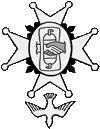ORIGINALLY THE CHAPEL had the same style as the rest of the crypt – Romanesque arches survive in the south wall and 11th-century stonework has been uncovered in the south-east corner.
The twin altars were dedicated, at first, to saints of the Dark Ages – one northern, one southern.
The northern honoured Northumbria's first apostle (before Aidan or Cuthbert) – Paulinus who accompanied Ethelburga, Princess of Kent, when she married King Edwin of Northumbria. In 633, following King Edwin's death in battle against the heathen King Penda of Mercia, Paulinus accompanied the widowed Ethelburga back to Kent, becoming Bishop of Rochester until his death in 644.
The southern altar was dedicated to a Frenchman – Audoen or Ouen, Bishop of Rouen (perhaps known to his friends as Ouen of Rouen) circa 600-84, some of whose bones, from around 960, the cathedral priory claimed to hold as miracle-working relics.
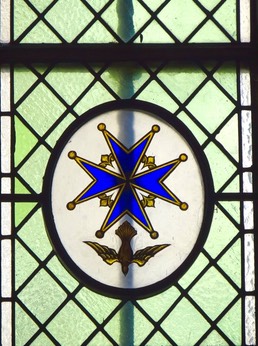
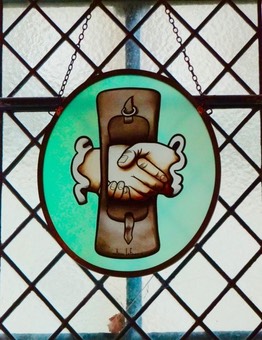
In the 1360s, when the chapel was remodelled, the altars were re-dedicated respectively to the Holy Trinity and St Mary the Virgin. These dedications were abandoned in the 16th century when the chapel was made available to the Walloon congregation of refugees from Belgium and Holland. In the window of the northern chapel there now hangs the badge of the Walloons, while in the southern one, the badge of their Huguenot successors echoes the previous link with France. Reflecting its joint ancestry, the badge of the French Protestant Church of Canterbury combines the two.
The perpendicular style of the windows (two perpendicular shafts in each) are part of the 14th-century design of the chapel overall, which has been recognised by some experts as the work of Henry Yevele, perhaps a prototype for his nave upstairs. The modernisation took place at the instigation of Prince Edward, generally known as the Black Prince, eldest son of King Edward III.
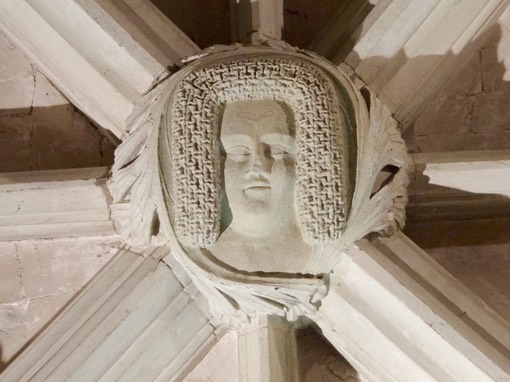
By remodelling the chapel, Prince Edward expressed gratitude to God and to the Pope who authorised his marriage (on 10 October 1361) to his half-cousin once removed, Joan, the so-called Fair Maid of Kent.
The couple were descended from different wives of King Edward I and had grown up together at court. Papal authorisation for the marriage was required because of their consanguinity, high status and complications from the bride's previous relationships.
Described by a contemporary as “the most beautiful woman in England – and the most amorous” – the new Princess of Wales had, some years previously, entered into concurrent contracts of marriage with two other men – a situation that had required the intervention of a previous Pope. One of the two men (by whom Joan had five children) had died. The other was still alive when Joan was authorised to marry the Prince of Wales.
The prince arranged with the cathedral priory for the chapel to be manned in perpetuity by two priests, who said mass at each altar on alternate days and the 'canonical hours' together every day at the Holy Trinity altar.
The priests were housed on a site in King Street, still known as Black Prince's Chantry and were paid a joint stipend of 40 marks (£26.66) The arrangement ceased at the Reformation.
Prince Edward died before his father, so the Princess of Wales was never Queen, though her youngest son became King Richard II. The princess was buried at Stamford, Lincolnshire.
Given the present use of the chapel, it is interesting to reflect on three facts:
1 King Edward III invited large numbers of Flemish weavers to live in Kent – for good commercial reasons so that our Kentish wool could be woven in this country rather being sent abroad.
2 Joan, Fair Maid of Kent, supported John Wycliffe and the Lollards, precursors of the English Reformation.
3 When Prince Edward died in 1376 he requested burial in the cathedral crypt near his chantry, not dreaming that one day (exactly 200 years after his death) the entire western crypt would be occupied by thousands of refugees from France and the Low Countries. Upstairs, far away from the sound of French hymns and French prayers, he might rest more easily were it not for the occupant of a neighbouring tomb. On the opposite side of Becket's sanctuary, lies King Henry IV, who usurped the throne of King Richard II – Joan and Edward's son.
The congregation of the French Protestant Church of Canterbury is nonconformist & proudly independent.
Dr Hugh Boudin, our Pasteur Emeritus, sometimes describes us as auto-cephalic. In other words, our only bosses are those on our ceiling.

Ceiling bosses
1 Two heraldic shields, said to be England's oldest representations of the Royal Arms in stone.
The lions (heraldic leopards) represent England. The fleurs de lys are for France. King Edward III claimed the French throne through his mother – sister of the previous monarch. The French invoked their so-called 'salic' law which forbade female monarchs and hence inheritance of the crown through females. Thus began the Hundred Years War.
The King's shield has two supporters. The other, with one supporter, carries Prince Edward's heraldic label identifying him as the King's son.
2 The themes of the other bosses are marital & martial – male prowess, female beauty, fertility, maternal affection, heads of relations, friends.
3 Martial

a) Several lion heads – symbol of England – some solo, some quadruple.
b) Lion fighting with griffin
c) Lion fighting with dragon
b) & c) presumably apply to the Prince's battles in France & Spain but which is which ?
d) Samson wielding a donkey's head – signifying his slaughter of Philistines with the jawbone of an ass – sometimes said to relate to the battle of Poitiers where French bodies were piled high.
4 Marital
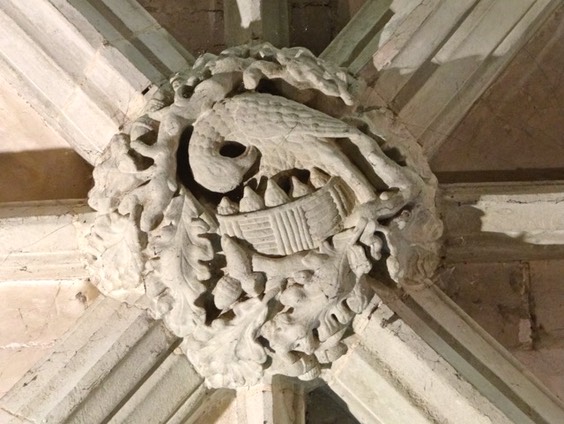
a) Green man – fertility signified by leaves.
b) Leaves – some gathered in wreaths or posies. Oak leaves are said to relate to Edmund of Woodstock, Earl of Kent – the bride's father or possibly further reference to the fertile leaves of the Green Man.
c) Flowers – female beauty – 5 petalled rose of England rosa canina – arranged in rings “ring a ring a roses”. Some people have suggested that they are sunflowers for purity, but was that flower known in 14th-century England ?
d) Pelican in her piety, feeding her young with blood from her own breast.
5 Faces
a) The bride with her hair in a gilded snood
b) Two women – perhaps the mothers of the happy couple, but neither is located near the carving of the bride. It is said that the Queen, though fond of Edward & Joan, did not wish them to marry. The woman near King Edward's shield is unlikely to be his own mother. Though it was through her that he claimed the French throne, they were not on good terms and she died three years before the prince's marriage. There are no distinguishing features to suggest that either woman was a Biblical character.
c) A third woman – near Samson – surely not Delilah! Any ideas?
d) A pointy-eared man. Who knows?
When in occupation of the western crypt, between 1576 and 1895 the French Walloon Church painted the arches with cartouches containing biblical quotations. Fragments can still be made out through the whitewash here and there, but here in the chapel above the crypt door is the only complete relic of those days, when the chapel served as an entrance lobby.
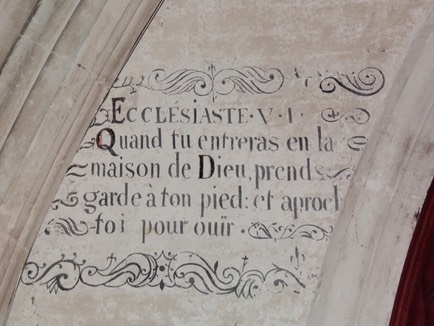
In English of the same period, (16th and 17th century) as displayed on the walls of several churches across Kent, the wording translates as 'Keep thy foot when thou goest to the house of God and be ready to hear'. Languages evolve and nowadays 'keep thy foot' is more obscure than 'prend garde à ton pied'.
© Michael H Peters 2007
